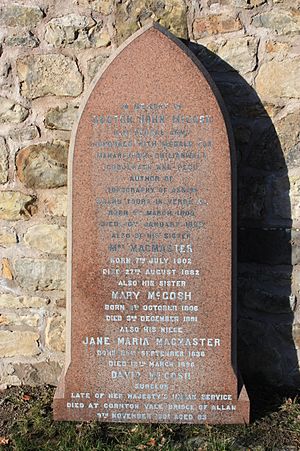John McCosh facts for kids
John McCosh was a Scottish army surgeon. He was also a talented photographer. He took many important pictures while serving in India and Burma.
He is best known for his photos during the Second Anglo-Sikh War (1848–1849). These pictures showed people and places connected to British rule in India. Some historians believe his work makes him the first known war photographer. McCosh also wrote books about medicine, photography, and even poetry.
Experts say his photos are a huge achievement. They are very important for understanding history. Unlike other photographers of his time, McCosh used photography to record history, not just as a hobby.
Contents
A Surgeon's Adventures and Early Photos

In 1831, when John McCosh was 26, he became an assistant surgeon. He joined the Indian Medical Service in the army of the East India Company. He served with the Bengal Army in India. He even saw action against the Kol people in 1832 and 1833.
A Shipwreck Survival Story
In 1833, McCosh was sailing from Madras to Australia. He was on sick leave because of a tropical disease. His ship, the Lady Munro, crashed near Amsterdam Island in the Indian Ocean. There were 97 people on board, but only 21 survived. McCosh was the only passenger who lived through it! A US ship rescued them later. He wrote a book about this amazing experience called Narrative of the Wreck of the Lady Munro (1835).
Training and Return to India
From 1840 to 1842, he went back to Edinburgh, Scotland. He studied more about surgery at Edinburgh University. In 1843, McCosh returned to India. He served as an assistant surgeon with the 31st Bengal Native Infantry. He took part in the Gwalior campaign and the Battle of Maharajpur. For his service, he received the Gwalior Star. It was around this time, either in 1843 or 1848, that McCosh started taking photographs.
He was sent to Almora in the Himalayas and to Jalandhar in the Punjab.
Photographing Wars and People
In 1848, McCosh was in the Punjab during the Second Anglo-Sikh War. He was a full surgeon with the 5th Battery, Bengal Artillery.
Photos from the Sikh War
During this war, McCosh mostly took portraits. He photographed fellow officers and important leaders. He also captured images of British administrators and their families. Some famous people he photographed included Hugh Gough, 1st Viscount Gough and General Sir Charles James Napier. He also took pictures of Dewan Mulraj, a key Sikh leader. Besides people, he photographed local people and buildings. His photos from this time were small, about 10 cm by 8 cm.
Pictures from Burma
McCosh also served in British Burma (now Myanmar). He was in Yangon (Rangoon) and Prome during the Second Burmese War (1852–1853). He took portraits of his colleagues and pictures of captured guns. He also photographed temple architecture in Yangon and Burmese people. His photos from Burma were larger, up to 20 cm by 22 cm. Some historians believe he was officially asked to photograph during this conflict.
First Photos of Places and People
McCosh took the very first photos of the Sikh people and palaces in Lahore. He also took the earliest known picture of the Samadhi of Ranjit Singh in 1849. His fifty photos of Burma from 1852 are the oldest surviving images of that country. They are also the first photographic studies of Burmese people.
Photography Techniques
McCosh mainly used a method called the calotype process. This was one of the first ways to create a negative image on paper. From this paper negative, he could make many positive prints. This process was invented by Henry Fox Talbot in 1841. McCosh also used a newer method called the collodion process. However, he often stuck with the calotype for larger prints because it captured more detail.
McCosh stopped taking photos around the early 1850s or 1856. He retired from the army on January 31, 1856. In 1862, he became a member of the Royal Geographical Society. John McCosh passed away in London in 1885. A memorial stone for him is in Dean Cemetery in Edinburgh, where his family is buried.
Where to See His Work
You can see John McCosh's photographs in these places:
- National Army Museum, London
- University of St Andrews, St Andrews, Scotland
- Victoria and Albert Museum, London
See also
- History of photography
- Linnaeus Tripe
- Willoughby Wallace Hooper
- Felice Beato
- Philip Adolphe Klier
- Max Henry Ferrars

